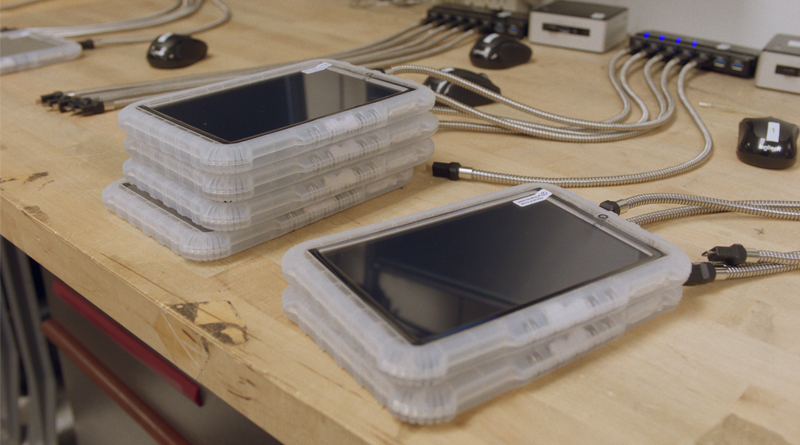Overcoming the Challenges of Installing Wireless Networks in Correctional Facilities
By Christopher Ditto
Correctional facilities are undergoing a digital renaissance. Everyday processes that have remained consistent for decades are changing, and new digital solutions are allowing facilities to increase operational efficiencies without staff involvement.
Most U.S. state prison systems today have some form of inmate tablet program, with many already on their second or third generation of devices. These tablets introduce inmates to incredible resources, from legal research to digital education, entertainment, and communication. However, their functionality is severely limited without wireless connectivity.
To maximize the value and impact of these new digital solutions, inmates and staff need access to interactive hardware, such as secure handheld devices, and a secure wireless network to provide a real-time link between the hardware and online software. The foundational challenge of deploying wireless digital solutions is that the unique architecture of correctional facilities presents significant barriers to installing and managing wireless networks.
Correctional facilities are designed around security, with thick concrete walls, steel doors, and metal cages in place to keep inmates inside and the public out. This infrastructure can interfere with wireless signals and cause network performance issues, and setting up wireless networks may necessitate drilling through or bypassing highly durable materials. Meanwhile, any network installation or repairs in housing areas could require inmates to be moved, and the facility may require additional procedures such as worker background checks and logistical management of tools brought on-site.
To overcome installation challenges and ensure wireless networks are secure and reliable, correctional leaders must make informed decisions around planning and implementation. The first step is to select an appropriate wireless protocol and spectrum. If the network is only intended to support low-bandwidth internet of things (IoT) devices, such as sensors or lighting and access controls, facilities can opt for a sub-Gigahertz (GHz) protocol. However, if the network is intended to support a wide variety of services, including those shared through handheld devices, WiFi may be a preferable alternative.
WiFi networks typically run on 2.4 Ghz or 5 GHz frequencies, which affects the speed and penetration of coverage. Additionally, facilities can also consider other options to meet their specific needs. Private LTE (pLTE) and MulteFire can run on a range of frequencies but require compatible devices, which may limit hardware options. Bluetooth is another protocol that is typically low-power but offers less range than WiFi. Devices that use public 4G and 5G networks operate on different frequency bands than WiFi and may offer better penetration, but connecting devices directly to a public network can weaken security measures such as firewalls and increase the risk of a breach.
Once a network protocol is selected, it is important to conduct a site survey both before and after installing the wireless network. This process will help detect any potential interference that may affect the wireless signal, determine how many access points are needed, and where they should be placed to ensure wireless coverage across all required locations. A useful diagnostic tool correctional leaders can utilize is a heat map that visualizes signal strength across the facility. This can help determine the selection and optimal placement of wireless antennas. However, the equipment cost for full coverage could be higher than expected as a correctional facility will likely require more — and tougher — equipment per square foot than typical commercial installations.
A clearer understanding of on-site connection needs will later help facilities begin developing a network design. This crucial step must take into account factors such as site security requirements, the number and type of concurrent devices that will access the network, and the bandwidth those devices will require. Moreover, facilities must ensure their equipment is resistant to tampering, adverse conditions, and even potential weaponization.
At a time when cybercrime and data breaches are rising, preventing unauthorized network access is a top priority. Correctional facilities can build resilience against cyber threats by implementing strong encryption protocols that require user authentication and user access controls. It is also important to continuously monitor the network for any signs of suspicious activity so that a potential red-flag issue can be immediately diagnosed and addressed.
Things change over time, and it is vital to regularly audit wireless networks to ensure the facility’s needs are being met. A network audit can include testing the signal strength and coverage, updating software, and performing maintenance tasks. Correctional facilities must also make sure that network users have a quick and easy way to report network issues, and that onsite staff are trained to troubleshoot potential issues.
A successfully installed wireless network is a crucial part of digital transformation within correctional institutions. By deploying a handful of simple yet effective solutions, facilities can overcome the challenges of installing and maintaining wireless networks and provide secure and reliable coverage for inmates and staff alike.
Christopher Ditto is Vice President of Research and Development at ViaPath Technologies.

